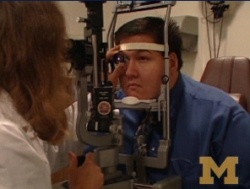I see diabetes in your eyes
Diabetes fires researchers imagination: Two scientists at the University of Michigan Kellogg Eye Center developed a new screening device that gives early warnings of diabetes and its vision complications within five minutes.

Keeping an eye on diabetes with FA
Metabolic stress, and therefore disease, can be detected by measuring the intensity of cellular fluorescence in retinal tissue, as Howard R. Petty and Victor M. Elner, researcher from the University of Michigan showed in earlier tests: they measured high levels of the so-called flavoprotein autofluorescence (FA) that act as a reliable indicator of eye diseases.
The researchers then transferred their investigation into a new medical device that captures images of the eye to detect metabolic stress and tissue damage that occur before the first symptoms of disease are evident, according to their study in the July issue of Archives of Ophthalmology
In their new study, Elner and Petty measured the FA levels of 21 individuals who had diabetes and compared the results to age-matched healthy controls. The Kellogg scientists found that FA activity was significantly higher for those with diabetes, regardless of severity, compared to those who did not have the disease. The results were not affected by disease severity or duration and were elevated for diabetics in each age group: 30 to 39 years, 40 to 49 years, and 50 to 59 years.
And furthermore: Twelve individuals in the study were known to have diabetic retinopathy, a disease in which blood vessels in the eye are damaged. The individuals with diabetic retinopathy in at least one eye had significantly greater FA activity than people with diabetes who do not have any visible eye disease. „That indicated that it may be possible to use this method to monitor the severity of the disease," says Elner.
A great number of people over the age of 40 suffer from diabetic retinopathy, an eye-related complication of diabetes that is the leading cause of blindness among working-age adults.
Given the increasing prevalence of diabetes, the FA device holds the potential to help address a leading and growing public health concern. For people with diabetes -- diagnosed or not -- the new device could offer potentially significant advantages over blood glucose testing, the "gold standard" for diabetes detection.
"Increased FA activity is the earliest indicator that cell death has occurred and tissue is beginning to break down," says Petty, professor of Ophthalmology and Visual Sciences, and professor of Microbiology and Immunology at the U-M Medical School. "FA serves as a 'spectral-biomarker' for metabolism gone awry, and we can use the results to detect and monitor disease."
Petty also observes that unlike glucose monitoring, elevation of FA levels reflects ongoing tissue damage. That knowledge, he says, could motivate patients to intensify their efforts to manage the disease.
The Michigan researchers also note that elevated FA does not always mean that an individual has diabetes. "Because of the prevalence of diabetes in our population, individuals with abnormally high FA would be prompted to undergo glucose tolerance testing," says Elner. "If the findings were negative for diabetes, we would look for other causes of ocular tissue dysfunction."
Both Elner and Petty agree that the device has great potential as a tool for diabetes screening and management. "So much damage occurs before the disease can be detected by a doctor," says Elner. "Early diagnosis will allow us to reduce organ damage and prevent many complications that accompany this disease." The researcher have filed for patents and have formed a company, OcuSciences, Inc., to commercialize the metabolic imaging instrument.
Photo: University of Michigan
24.07.2008
More on the subject:










